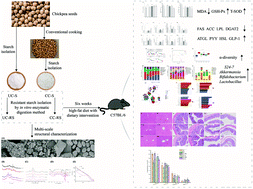Anti-hyperlipidemic and ameliorative effects of chickpea starch and resistant starch in mice with high fat diet induced obesity are associated with their multi-scale structural characteristics†
Abstract
Chickpea starches were isolated from both untreated (UC-S) and conventionally cooked seeds (CC-S), and their multi-scale structural characteristics and in vivo physiological effects on controlling hyperlipidemia in high fat diet induced obese mice were compared with their corresponding resistant starch (RS) fractions obtained by an in vitro enzymatic isolation method (UC-RS and CC-RS). The degree of order/degree of double helix in Fourier transform infrared spectroscopy was in the following order: CC-RS > UC-RS > CC-S > UC-S, which was consistent with the trend observed for relative crystallinity and double helix contents monitored by X-ray diffractometer and solid-state 13C cross-polarization and magic angle spinning NMR analyses. The influence of different types of chickpea starch and their corresponding resistant starch fractions on regulating the serum lipid profile, antioxidant status, and histopathological changes in liver, colon and cecal tissues, and gene expressions associated with lipid metabolism, gut microbiota, as well as short-chain fatty acid metabolites in mice with high fat diet induced obesity was investigated. The results showed that the chickpea RS diet group exhibited overall better anti-hyperlipidemic and ameliorative effects than those of the starch group, and such effects were most pronounced in the CC-RS intervention group. After a six-week period of administration with chickpea starch and RS diets, mice in the UC-RS and CC-RS groups tended to have relatively significantly higher levels (P < 0.05) of butyric acid in their fecal contents. The 16S rRNA sequencing results revealed that mice fed with CC-RS showed the greatest abundance of Akkermansia and Lactobacillus compared with the other groups.



 Please wait while we load your content...
Please wait while we load your content...